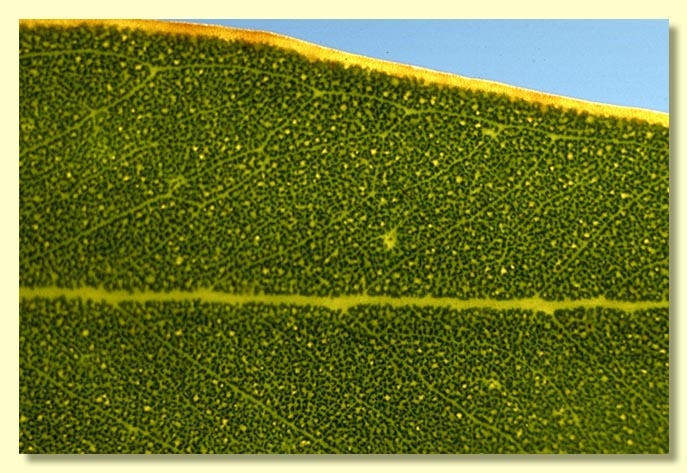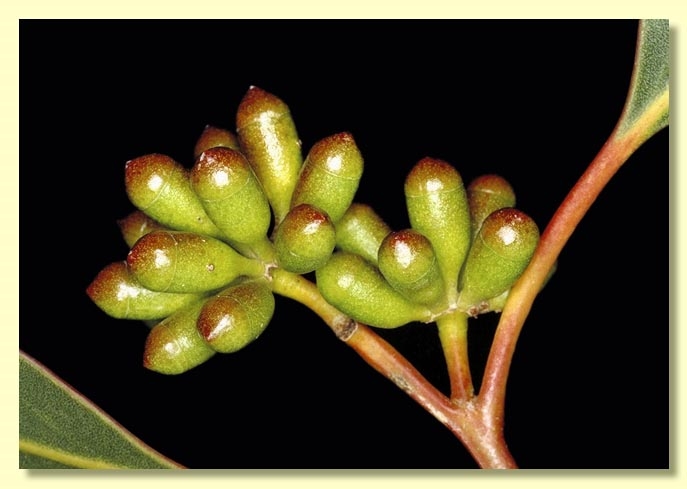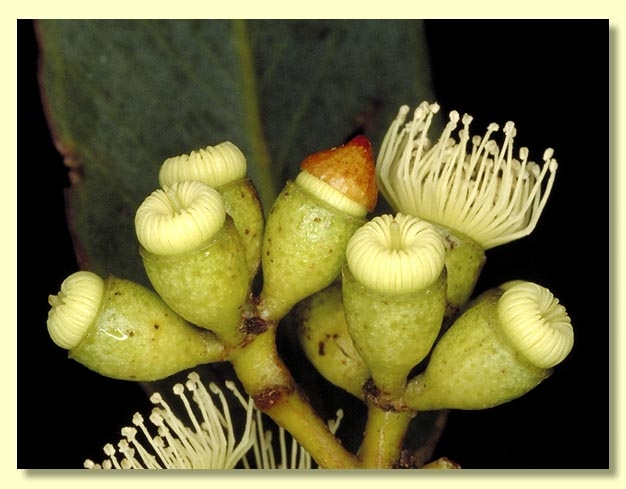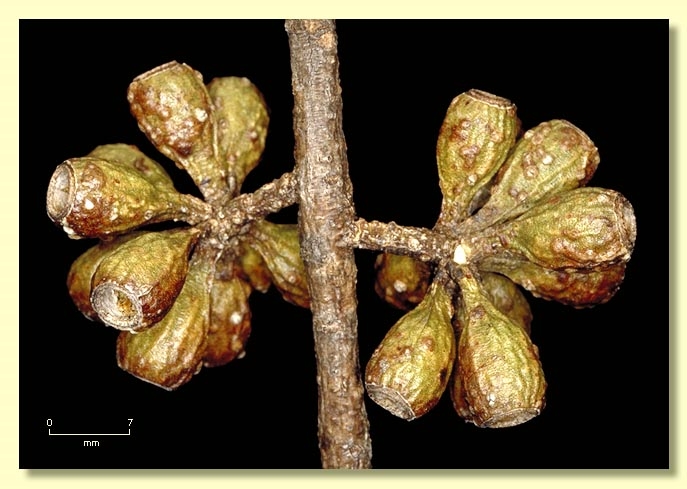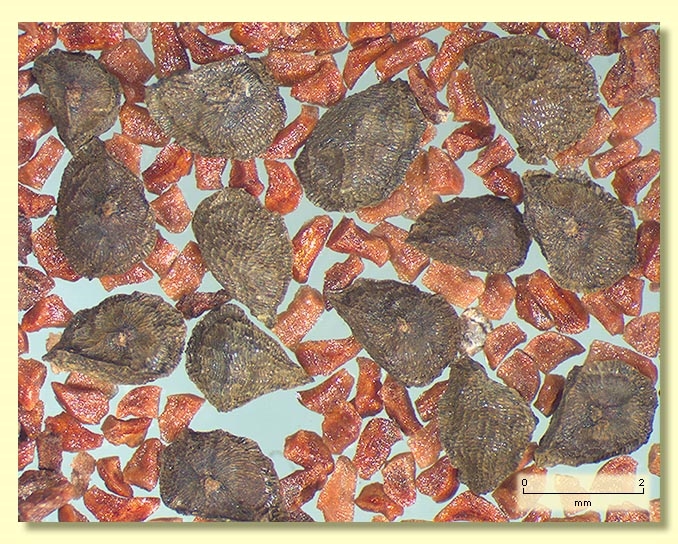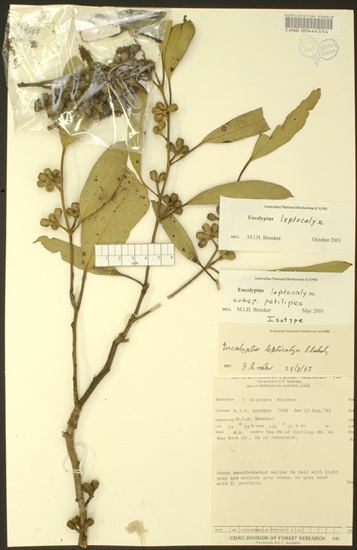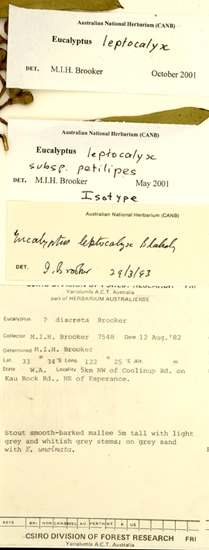Euclid - Online edition
Eucalyptus leptocalyx
Eucalyptus | Symphyomyrtus | Dumaria | Furfuraceae
T: 9 mile Tank from Hopetoun, W.A., Sept. 1909, J.H.Maiden s.n.; syn: CANB, K, NSW, PERTH (see image of type specimen held at CANB); Grass Patch, W.A., 23 May 1924, C.A.Gardner 2221; syn: NSW.
Eucalyptus leptocalyx subsp. petilipes L.A.S.Johnson & K.D.Hill, Telopea 9: 287 (2001). T: Western Australia: 5 km NW of Coolinup Road on Kau Rock Road, NE of Esperance (33°34'S, 122°25'E), 12 Aug. 1982, M.I.H.Brooker 7548; holo: NSW; iso: CANB, PERTH.
Bark wholly smooth, brownish-white and grey over light salmon-pink.
Oil glands present in pith of branchlets.
Juvenile growth (coppice or field seedlings to 50 cm): stems rounded in cross-section; juvenile leaves always petiolate, alternate, ovate, 5–8.5 cm long, 3–4.5 cm wide, base tapering to petiole or rounded, apex rounded or pointed, dull light green to bluish green (not glaucous).
Adult leaves alternate, petioles 1.2–3.5 cm long; blade lanceolate, 7.5–12 cm long, 1–2.8 cm wide, base tapering to petiole, margin entire, apex pointed, concolorous, slightly glossy, green, side-veins at an acute or wider angle to midrib, reticulation dense to very dense, intramarginal vein remote from margin, oil glands mostly intersectional, irregular.
Inflorescence axillary unbranched, peduncles 0.5–1.5 cm long, buds 7, 9 to 15, pedicellate (pedicels 0.1–0.6 cm long). Mature buds cylindrical (0.8–1.3 cm long, 0.4–0.6 cm wide), scar present, operculum conical to slightly beaked (0.2–0.5 cm long), smooth or scarcely striate, stamens inflexed, anthers cuboid, versatile, dorsifixed, dehiscing by longitudinal slits, style long and straight, stigma blunt to rounded, locules 4 or 5, the placentae each with 4 vertical rows of ovules. Flowers creamy white, very rarely red.
Fruit pedicellate (pedicels 0.1–0.5 cm long), barrel-shaped to cylindrical, 0.7–1.2 cm long, 0.6–0.8 cm wide, disc descending vertically, valves 4 or 5, enclosed.
Seeds black-brown to grey-brown sometimes with paler, scurfy area on ventral side, 1.8–3.2 mm long, flattened-ovoid, dorsal surface shallowly reticulate, some seed with narrow partial flange, hilum ventral.
Cultivated seedlings (measured at ca node 10): cotyledons reniform; stems rounded to square in cross-section; leaves always petiolate, opposite for 4 or 5 nodes then alternate, ovate, 3.5–6.5 cm long, 2–5.5 cm wide, dull, green to blue-green.
Flowering has been recorded in January, March, September, October, November and December.
A mallee or rarely a tree, endemic to Western Australia, found in southern coastal and subcoastal areas from Fitzgerald River National Park east towards Israelite Bay. The bark is smooth and the adult leaves glossy green.
Eucalyptus leptocalyx belongs in Eucalyptus subgenus Symphyomyrtus section Dumaria because the buds have two opercula, stamens are strongly inflexed, ovules are in four rows on the placentae and cotyledons are reniform. Within this subgroup E. leptocalyx is closely related to only two other species—E. scyphocalyx and E. platycorys—the three species forming series Furfuraceae. All have flattened grey-brown seed that have a pale scurfy patch on the underside and have branchlets with oil glands in the pith.
E. leptocalyx is distinguished from E. scyphocalyx and E. platycorys by the combination of smooth bark, cylindrical buds in umbels of nine to 15 and barrel-shaped fruit to 0.8 cm wide. Both the coastal smooth-barked E. scyphocalyx and inland rough-trunked E. platycorys tend to have cylindrical-pyriform buds and cylindrical-cupular fruit. E. platycorys also differs by having buds in umbels of three or seven and larger fruit with a wide vertical scar left on the rim by the shedding on the inner operculum at flowering.
The bud and fruit shape of E. leptocalyx parallel that of E. cylindrocarpa, which belongs in a different series and has a more inland distribution.
The more recently published Eucalyptus leptocalyx subsp. petilipes is regarded here as not significantly different from E. leptocalyx Blakely and in any case the cited type specimen of subsp. petilipes is also cited on the next page of the same publication as representing an intergrade between E. leptocalyx subsp. leptocalyx and E. leptocalyx subsp. petilipes (see Hill et al, 2001).



